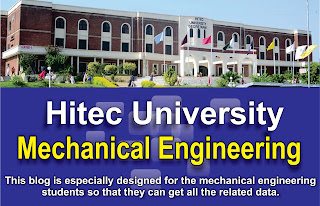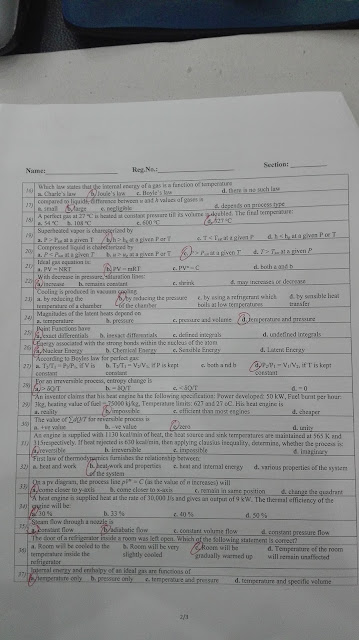Showing posts with label first law of thermodynamics. Show all posts
Thermodynamics 2
By : Asad Ali Arshadthermo-lab-1.docx
null
Thermodynamics
Branch of science that studies changes in energy.
Temperature, Pressure, Volumeare driving forces for energy.
Types of Heat
(1) Latent Heat:
Related to phase change i.e. melting of ice. Boilers, Evaporator.
(2) Sensible Heat:
Heat can be sensed (No phase change) e.g. Heaters. Air conditioners.
Laws of Thermodynamics
First Law of thermodynamics:
Energy can neither be created now destroyed but it can be changed from one form to another.
Also called law of conservation of energy.
ein-eout=constant
ein=eout
ΔU=Q+W
Q= Heat exchanged b/w system.
W=Work done.
 |
Second Law of thermodynamics:
Entropy of a system also increases never decreases.
Entropy:
Measure of disorder of energy of a system.
Zeroth Law of thermodynamics:
Kelvin Statement
No device can be worked with single reservoir. .e.g. car-engine.
Clauses Statement
Heat cannot be transferred from low to higher reservoir. E.g. refrigerator
Second Law of thermodynamics:
For a pure crystalline structure entropy is zero at absolute zero.
Microscopic Properties:
Study of each atom or molecule separately.
Macroscopic properties:
Study of each atom or molecule as whole average.
System:
Anything under consideration is system.
Surrounding:
Everything except system is surrounding.
Boundary:
The separation b/w system and surrounding is boundary.
Closed System:
A fixed amount of mass is chosen for study.
Open System:
Thermodynamics
By : Asad Ali ArshadChapter no 2 : Energy,Energy transfer and General Energy Analysis.
If we take the entire room—including the air and the refrigerator (or fan)—as the SYSTEM, which is an
Adiabatic Closed System since the room is well-sealed and well-insulated, the only energy interaction
involved is the Electrical Energy crossing the system boundary and entering the room
- As a result of the conversion of Electric Energy consumed by the device to Heat the room temperature will rise
- Form of Energy
- Some Physical Insight to Internal Energy
- Mechanical Energy
- Energy Transfer by Heat
- Energy Transfer by Work
- Heat vs Work
- The first law of themodynamics
- The First Law of Thermodynamics for a Control Mass Undergoing a Cycle
- The First Law of Thermodynamics for a Change In State of a Control Mass
In the slides a very detail description about these topics are given for learning these topics you shoult consult with the following slides and for further detail about the thermodynamics you should read the other lecture uploaded on this blog.
chapter 2.pdf
null
Hitec Mechanical Engineering
Mechanical Engineeirng Hitec Mechanical Engineering As we know Mechanical Engineering is the branch of engineering dealing with the des...
















